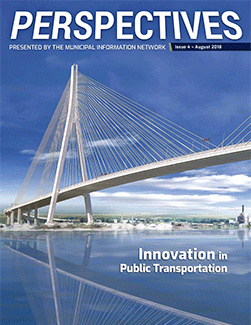While governments around the globe pour billions into expensive "Rapid Transit" primarily for daily commuters, the private sector and researchers are investing other billions into the "Rapid Movement" of people, goods and services.
As we learn about the relatively simple experiments of drone pizza delivery, researchers at the Massachusetts Institute of Technology (MIT) and at the University of Singapore are taking their research of driverless vehicle technology to sidewalks with the development of autonomous scooters. Companies such as Google and Tesla are doing the same, but for roadworthy vehicles.
It is conceivable that package delivery by drones will compete with the delivery of packages by autonomous vehicles. Delivery companies like FedEx and Amazon will have to face new forms of competition not contemplated by most of us a decade ago. Moving goods and services will look very different within 10 years.
But what about moving people? Somehow we are comfortable with the autonomous delivery of the pizza, but will we be OK with strapping grandma into a seat at the local drone arrival and departure station?
While today it seems natural that air passengers know their pilots are flying while on "auto pilot", would it then be safe to assume that in the future those same passengers would accept riding in a car that is moving in autonomous mode with virtually anyone (or no one) in the driver's seat?
We are all aware that Google has been testing a car that is being piloted (with mixed results) driving autonomously. Meanwhile, the traditional auto manufacturers of General Motors, Toyota, Audi, Ford and Nissan are also all advancing their driverless initiatives.
Assuming the legislative framework can keep up with the technological advances, such transportation methods are soon to be a real-world experience in many jurisdictions.
Commuting in the Future
The innovative minds of Silicon Valley have solved many of our everyday life problems and introduced much to give us our conveniences. But, they still have not provided a solution to the world for one of our biggest headaches: rush hour.
The time of solving that issue may be sooner than we think.
Commuting to downtown Toronto or Vancouver from the suburbs is spoken about in 30 minute increments. It can add an hour or two to one's daily work-life. Daily gridlock occurs in Sao Paulo, Madrid, London, Mumbai and Tokyo and most other big cities. It is expensive and frustrating for commuters, most of whom are in Single Occupancy Vehicles.
Around the world, experts are searching for the magic answer for this gridlock. So far the solutions are High Occupancy Lanes (HOV), synchronizing traffic signals or various forms of rapid transit systems.
The first steps in solving the rush hour gridlock may indeed be the delivery of packages (and pizza) as pilot projects. Taking courier vehicles off the road may be the first step; after all, they too are traffic!
Delivery Services Are Changing
In Singapore, it is Airbus attempting to come to the rescue: the Civil Aviation Authority of Singapore signed a Memorandum of Understanding that would permit Airbus Helicopters to perform a pilot test with the University of Singapore for drone parcel delivery on the University campus. That campus was abuzz on February 8, 2018 as Airbus completed the first flight demonstration of its Skyways air vehicle with no person aboard.
What is also important to note was that Singapore Post joined as a logistics partner in this process. Postal service companies know all too well that their industry is under siege.
In Singapore it remains to be seen whether drones will be authorized to deliver parcels to other points on the island, although good progress has been reported. It simply feels like a matter of time. The success of that pilot project would require the demonstration of safe operations of the skyways. Another key challenge is that regulations must keep up with the pace of the technological advances.
Will Airbus, Amazon, FedEx and Boeing become competitors in the delivery of goods, services and people in the future? It is easy to envision that scenario.
Then there is the top secret Airbus Helicopter where developers are working on an aerial vehicle. This so-called "CityAirbus", looking like a large drone, would operate initially with a real person as pilot and carry passengers over top of the car commute at a price that competes with regular commuting costs or taxi costs. This is a time convenience that would be attractive to many.
The challenge of flying vehicles over urban areas is fraught with difficulties and would be compounded significantly if these became flying autonomous vehicles without a pilot at the controls. But, that possibility can be easily imagined.
Many municipalities across Canada last year submitted proposals that were focused on winning Federal Government "prize money" for "smart city" initiatives. While experts in Canada and throughout the world are talking about the smart cities of the future, most are focused on smart ground mobility.
Some of the smart city visionaries are now looking into the concepts of solutions that involve the sky. While solutions for scooters, bikes, cars, electric vehicles and autonomous cars are all important, solutions in the air may be the solutions chosen as the real pioneers of the next smart city challenge. The short list of possible winners released on June 1 in the current Canadian Smart City contest did not include any air mobility solutions.
Today, most drones are small and are used as mobile cameras, but a Chinese drone maker, Ehang Corp, has been testing its Ehang 184, designed to transport people. While today the Ehang 184 only has capacity for one person up to 100 kg, on its website, Ehang states that the "EHANG 184 AAV is a safe, smart and Eco-Friendly low-altitude autonomous aerial vehicle aimed at providing a medium short-distance communication and transportation solution". After 1,000 test flights in Nevada, the company states its intent is to provide the opportunity for a passenger to sit at the controls and not a pilot--a real difference, of course!
Following Tesla's lead, Ehang will likely look first to transporting wealthy customers to establish a customer base while working with regulatory authorities in jurisdictions where there is a friendly reception to such a notion.
What the future of "Rapid Transit" and "Rapid Movement" will be is not yet fully understood or easily envisioned. It is wise nevertheless for elected leaders across Canada to stay abreast of this evolution as they continue to sink billions into transit systems that may be obsolete as quickly as technological advances offer options.
Just as Uber and Lyft are changing the face of the ride-share industry, so will the drone and autonomous modes change the face of moving goods and services. Time will tell if it changes the face of how we are moving people. For the future of urban mobility, smart communities should look to the sky.








